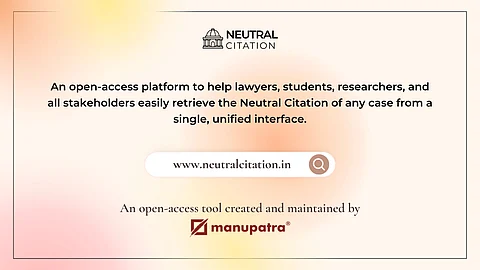
- Latest Legal News
- News
- Dealstreet
- Viewpoint
- Columns
- Interviews
- Law School
- Legal Jobs
- हिंदी
- ಕನ್ನಡ

It’s a busy Tuesday morning in a Delhi courtroom.
Advocate Mehta is presenting a Supreme Court judgment to support his argument. He refers to a citation from a widely used private law reporter. Across the room, the opposing counsel counters with the same judgment — but cited from a different publisher. Paragraphs don’t align. The page numbers are off.
The judge, referencing yet another version from their own notes, pauses the arguments.
“Counsel, please clarify — are you referring to paragraph 12 or 15? Because in my copy, they don’t match.”
A simple citation has turned into a confusing detour. Precious court time is lost aligning versions of a judgment everyone agrees on, but which no one is citing the same way.
This isn’t just one courtroom’s problem. Across India, judges and lawyers have long struggled with the challenge of many citations — caused by the sheer number of private publishers, court-published law reports, legal databases, and varying report formats.
That’s the promise of Neutral Citation — a standardized, court-issued identifier that ends the confusion and brings consistency to how we reference case law.
In a landmark move, to ease the adjudicatory process and to avoid confusion arising out of one case being cited by different people in a number of different ways (as they may rely upon different sources to read the reported case laws), the Supreme Court of India in July 2023 implemented the Neutral Citation System. This is a uniform and secure methodology that enables courts to publish judgments in the public domain using a consistent method of citation.
Neutral Citation is a simple yet powerful idea: every judgment receives a unique identifier based on the order in which it is delivered during the year. For instance, a Supreme Court judgment might be cited as 2024 INSC 1, where:
“2024” is the year,
“INSC” stands for the Supreme Court of India,
and “1” indicates it was the first judgment of that year.
This identifier remains constant — neutral, permanent, and universally applicable — transforming how judgments are cited by lawyers, judges, students, and researchers.
So, whether you're accessing the judgment from the Supreme Court’s website, a legal tech platform like Manupatra, or a government portal, the reference remains identical. Paragraph numbers align. Interpretation’s match. Confusion is eliminated.
With the Supreme Court implementing the Neutral Citation system and High Courts following suit, the legal ecosystem needed a bridge — a practical way to connect legacy publisher citations with the new uniform identifiers. NeutralCitation.in, launched by Manupatra, fills this critical gap by making access to neutral citations seamless, at no cost.
Users can input a citation like [2024] 11 SCR 1 and retrieve the matching neutral citation, such as 2024 INSC 835, within seconds. The platform bridges a crucial gap - bringing together fragmented legal references into a unified, searchable, and authoritative format.
This initiative reinforces the broader objective of democratizing legal information and ensuring a level playing field for all legal practitioners, regardless of geography or resources.
Indian courts are now proactively uploading official judgment copies, many with QR codes and digital signatures for authenticity. These official versions are accepted in legal submissions and are increasingly preferred by the judiciary.
Using copies from multiple sources often leads to inconsistencies — discrepancies in formatting or paragraphing can disrupt court proceedings and confuse interpretation. Submitting versions from different sources only adds to a judge’s burden. One judgment, two versions — it’s no longer necessary.
A single source of truth — the court-issued copy — is the most efficient and accurate option.
With the launch of NeutralCitation.in, a free public platform, access to standardized citations is now streamlined and universal. More than just a formatting fix, Neutral Citation marks a vital step toward bringing clarity, consistency, and equal access for all.
So, the next time you cite a case, ask yourself:
Are you helping the court move forward, or holding it back in an outdated loop?
Cite smart. Cite right. Cite neutral.
About the author: Priyanka is the COO of Manupatra, a pioneering legal tech company in India since 2000, simplifying legal research and legal operations at scale
Disclaimer: This is a sponsored post by Manupatra.